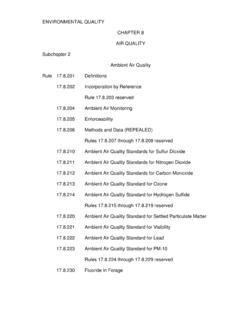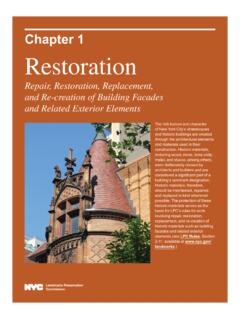Transcription of CIRCULAR DEQ 4 - Montana
1 CIRCULAR DEQ 4 Montana STANDARDS FOR SUBSURFACE WASTEWATER TREATMENT SYSTEMS 2013 Edition CIRCULAR DEQ 4 Page 2 of 159 2013 Edition FOREWORD These standards, based on demonstrated technology, set forth requirements for the design and preparation of plans and specifications for subsurface wastewater treatment systems. Users of these standards need to be aware that subsurface wastewater treatment systems are considered by the Environmental Protection Agency to be Class V injection wells and may require associated permits.
2 These standards are a revision of Department of Environmental Quality (DEQ) Circulars WQB-4, WQB-5, and WQB-6, 1992 Editions, and CIRCULAR DEQ-4, 2000, 2002, 2004, and 2009 Editions. CIRCULAR DEQ 4 Page 3 of 159 2013 Edition CIRCULAR DEQ-4 CHAPTER 1. INTRODUCTION .. 5 APPLICABILITY .. 5 DEFINITIONS .. 9 2. SITE CONDITIONS .. 17 SITE EVALUATION .. 17 SITE MODIFICATIONS .. 21 3. WASTEWATER .. 25 WASTEWATER FLOW .. 25 HIGH STRENGTH WASTEWATER .. 29 WATER TREATMENT WASTE RESIDUALS.
3 33 4. COLLECTION, PUMPING, AND EFFLUENT DISTRIBUTION SYSTEMS .. 34 COLLECTION SYSTEMS .. 34 PUMPING SYSTEMS .. 37 EFFLUENT DISTRIBUTION SYSTEMS .. 42 5. PRIMARY TREATMENT .. 49 SEPTIC TANKS .. 49 6. SOIL ABSORPTION SYSTEMS .. 56 STANDARD ABSORPTION TRENCHES .. 56 SHALLOW-CAPPED ABSORPTION TRENCHES .. 61 AT-GRADE ABSORPTION TRENCHES .. 66 DEEP ABSORPTION TRENCHES .. 69 SAND-LINED ABSORPTION TRENCHES .. 71 GRAVELLESS TRENCHES AND OTHER ABSORPTION METHODS .. 73 ELEVATED SAND MOUNDS.
4 78 EVAPOTRANSPIRATION ABSORPTION AND EVAPOTANSPIRATION SYSTEMS .. 83 SUBSURFACE DRIP .. 90 GRAY WATER IRRIGATION 97 ABSORPTION BEDS .. 102 7. ADVANCED WASTEWATER TREATMENT SYSTEMS .. 104 RECIRCULATING MEDIA TRICKLING FILTERS .. 104 INTERMITTENT SAND FILTERS .. 106 RECIRCULATING SAND FILTERS .. 109 AEROBIC WASTEWATER TREATMENT UNITS .. 112 CHEMICAL NUTRIENT-REDUCTION SYSTEMS .. 114 ALTERNATE ADVANCED TREATMENT SYSTEMS .. 115 8. MISCELLANEOUS .. 116 HOLDING TANKS.
5 116 SEALED (VAULT) PIT PRIVY .. 117 UNSEALED PIT PRIVY .. 118 SEEPAGE PITS .. 119 WASTE SEGREGATION .. 120 EXPERIMENTAL SYSTEMS .. 122 APPENDIX A - PERCOLATION TEST PROCEDURE .. 124 CIRCULAR DEQ 4 Page 4 of 159 2013 Edition APPENDIX B - SOILS AND SITE CHARACTERIZATION .. 127 APPENDIX C - GROUND WATER OBSERVATION WELL INSTALLATION AND MEASURING PROCEDURES .. 139 APPENDIX D - OPERATION AND MAINTENANCE PLAN .. 142 APPENDIX E - design EXAMPLES .. 146 APPENDIX F - REFERENCED DOCUMENTS.
6 158 CIRCULAR DEQ 4 Page 5 of 159 2013 Edition 1. INTRODUCTION APPLICABILITY General These minimum standards apply to all subsurface wastewater treatment systems in Montana . In some cases, a reviewing authority (other than the Department of Environmental Quality) may have requirements that are more stringent than those set out in this CIRCULAR . The term "reviewing authority," as used in these standards, refers to the Montana Department of Environmental Quality as referenced in the Sanitation in Subdivisions Act, Public Water Supply Act or Water Quality Act.
7 The term "reviewing authority" can also be a division of local government delegated to review public wastewater systems pursuant to Administrative Rules of Montana (ARM) , a unit of local government that has adopted these standards pursuant to 76-3-504, Montana Code annotated (MCA), or a local board of health that has adopted these standards pursuant to 50-2-116, MCA. Chart 1 shows this relationship graphically. CHART 1 CIRCULAR DEQ-4 Montana Standards for Subsurface Wastewater Treatment Systems Size design construction Sanitation in Subdivisions Act 76-4-101, et seq.
8 , MCA Public Water Supply Act 75-6-101, et seq., MCA Water Quality Act 75-5-101, et seq., MCA Local Health Boards 50-2-116, MCA Subdivision and Platting Act 76-3-101, et seq., MCA DEQ Subdivision Rules ARM , et seq. DEQ Public Water and Sewer Rules ARM , et seq. DEQ Nondegradation Rules ARM , et seq. State Minimum Standards ARM , et seq. Local Health Regulations Local Subdivision Regulations CIRCULAR DEQ 4 Page 6 of 159 2013 Edition Types of Systems This CIRCULAR describes different types of wastewater treatment and disposal systems for use in subsurface effluent discharge.
9 These systems typically consist of a collection system, septic tank, distribution box, or manifold and a series of subsurface laterals for effluent allocation. All wastewater applied to the subsurface treatment system must meet residential strength parameters. The method and pattern of effluent discharge in a subsurface absorption system are important design elements; distribution of effluent may be either through gravity flow application or pressure dosing. The gravity flow method of effluent distribution discharges wastewater from the septic tank or other pretreatment tank directly to the subsurface treatment system as incoming wastewater displaces it from the tank(s).
10 It is characterized by the term "trickle flow" because the effluent is slowly discharged over much of the day. Typically, tank discharges are too low to flow throughout the entire subsurface network; thus, distribution is unequal and localized. Overloading of the infiltration surface may occur. Without extended periods of little or no flow to allow the subsoil to dry, hydraulic failure is possible. Pressure dose distribution accumulates wastewater effluent in a dose tank from which it is periodically discharged under pressure to the subsurface treatment system by a pump.











